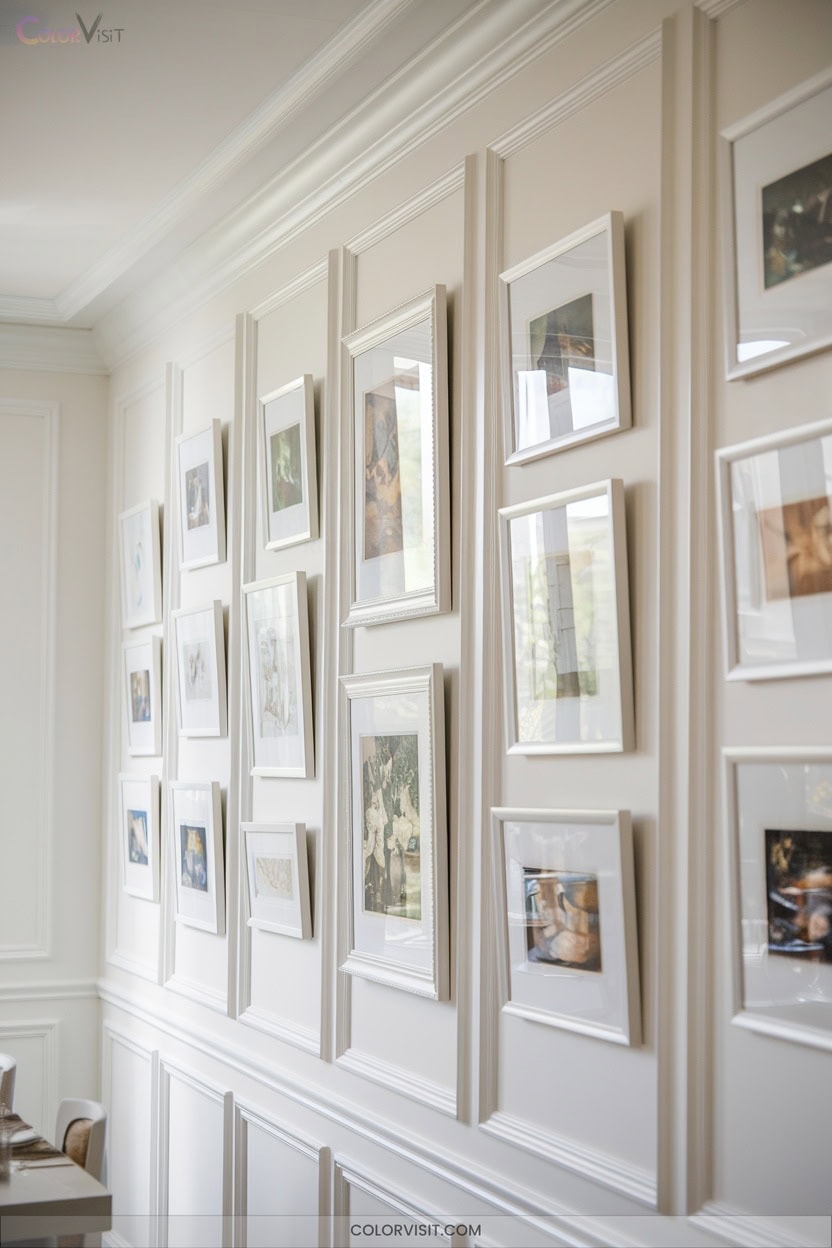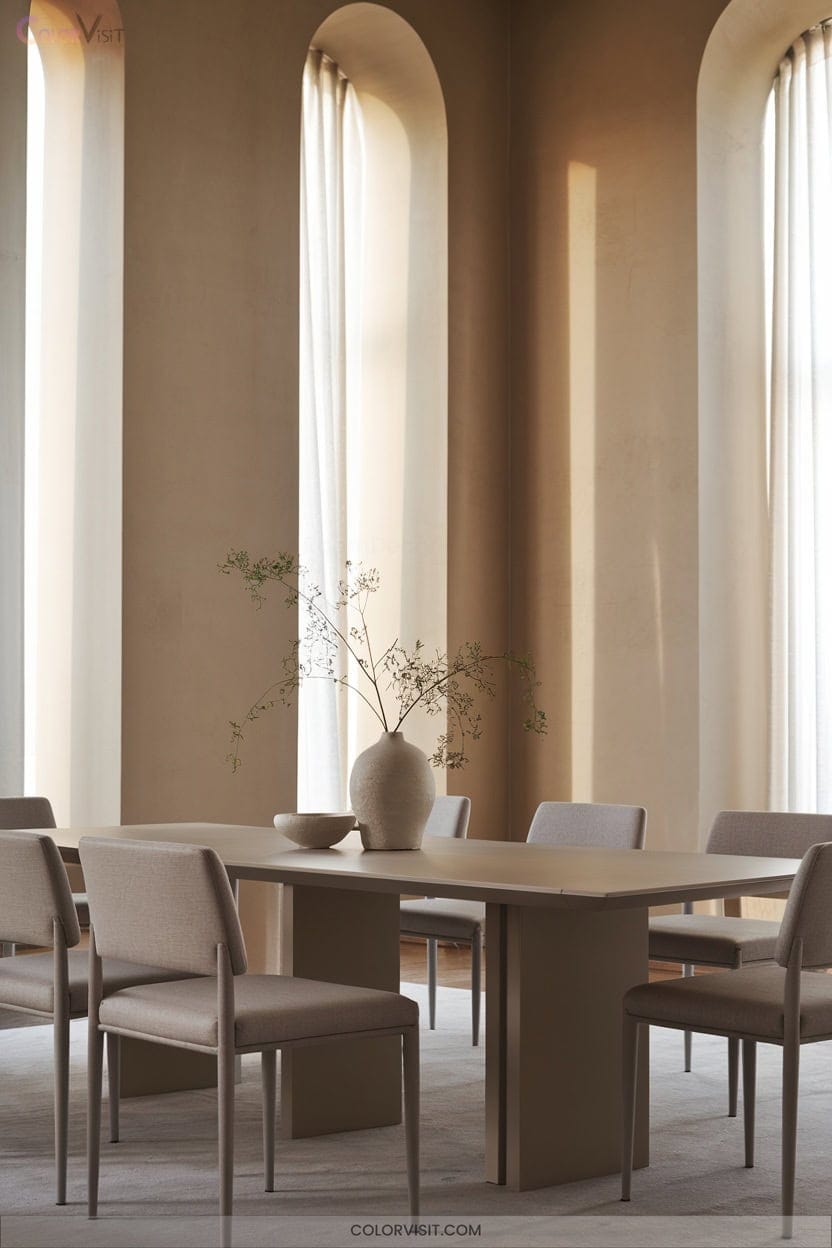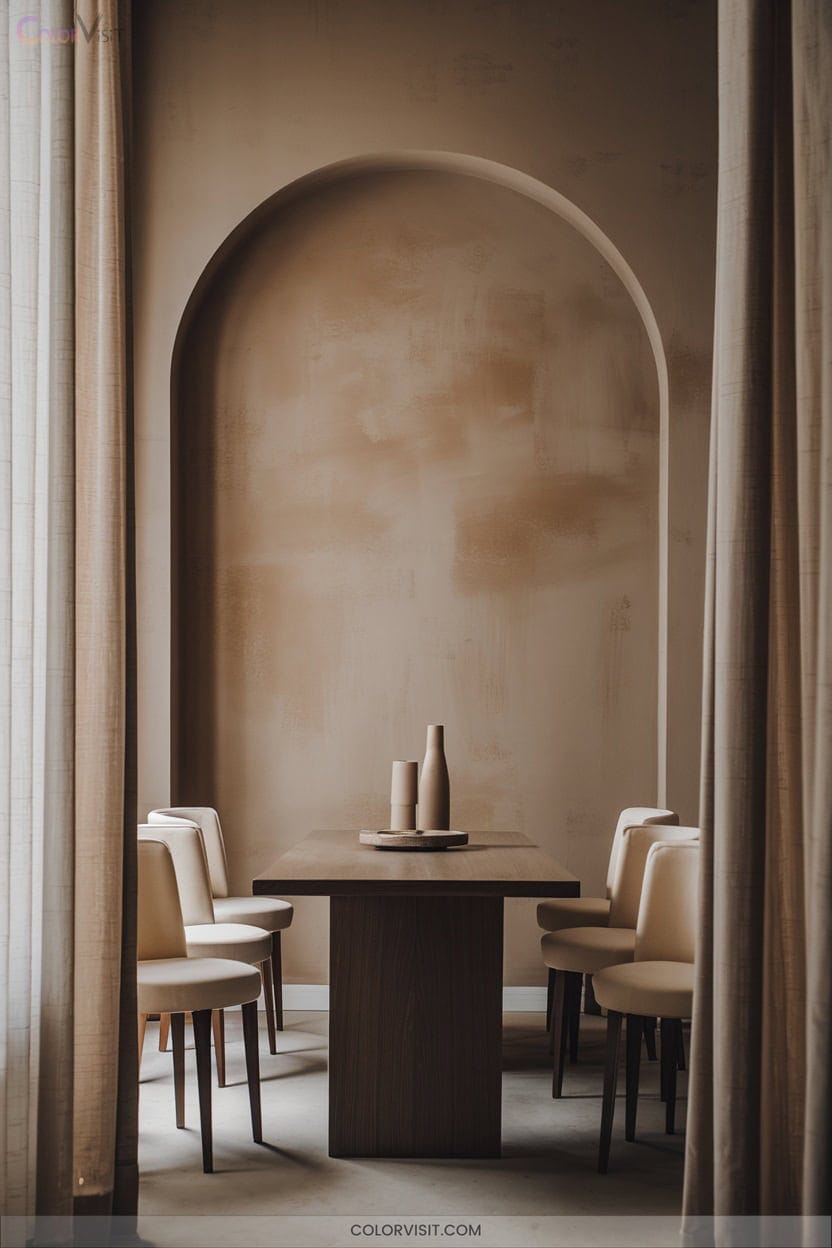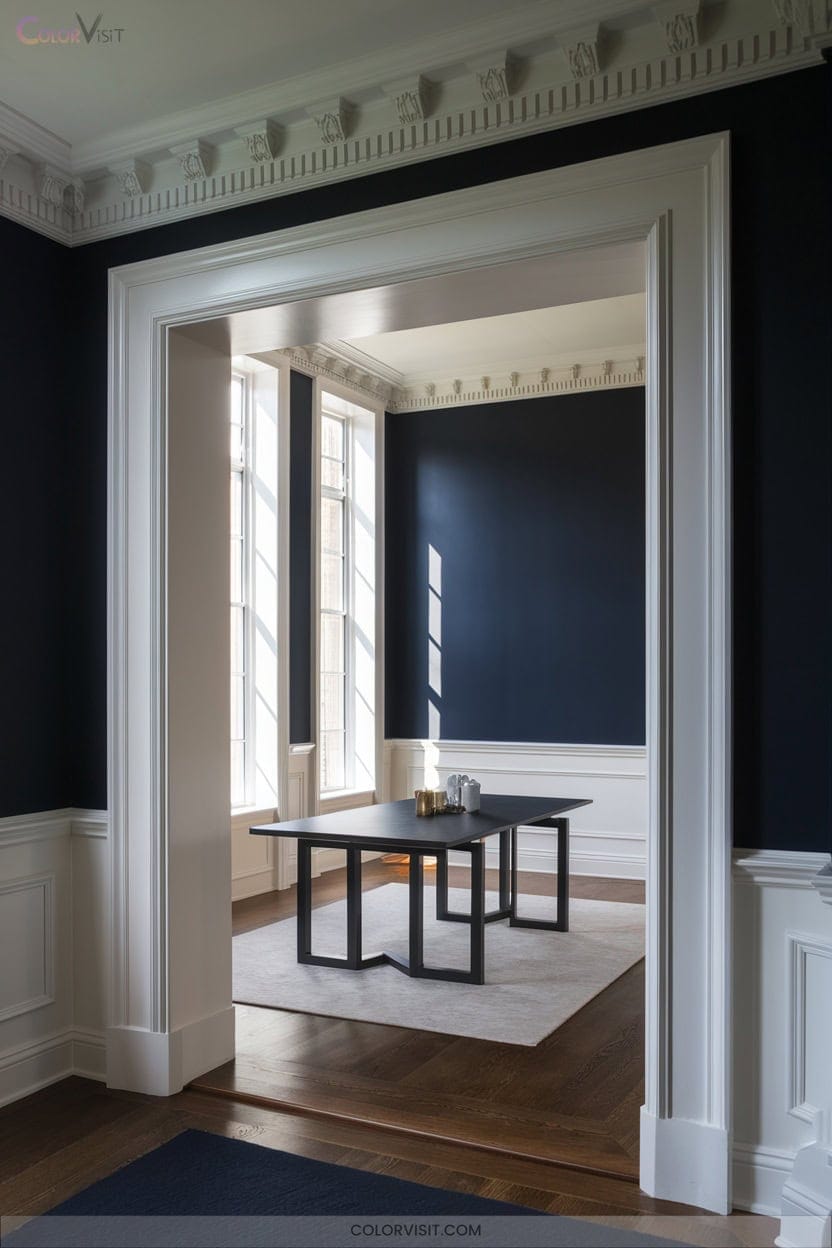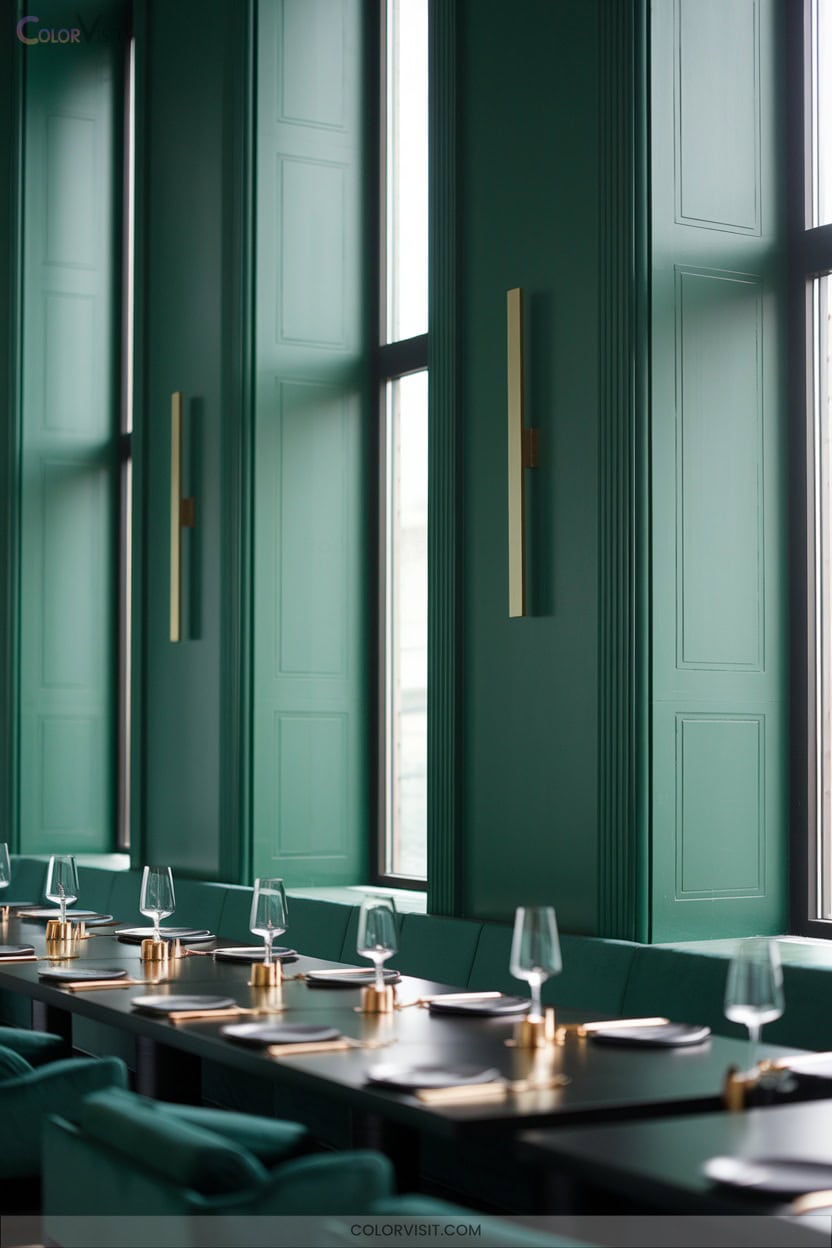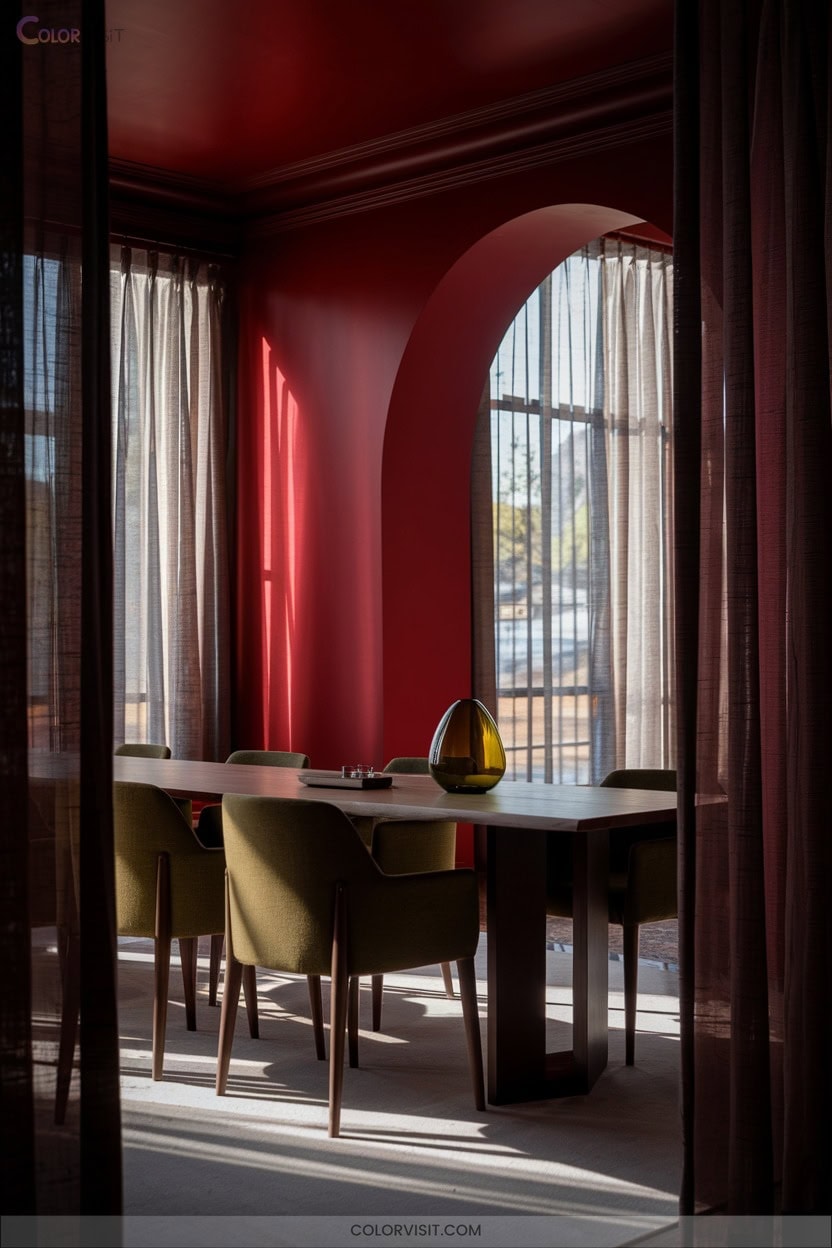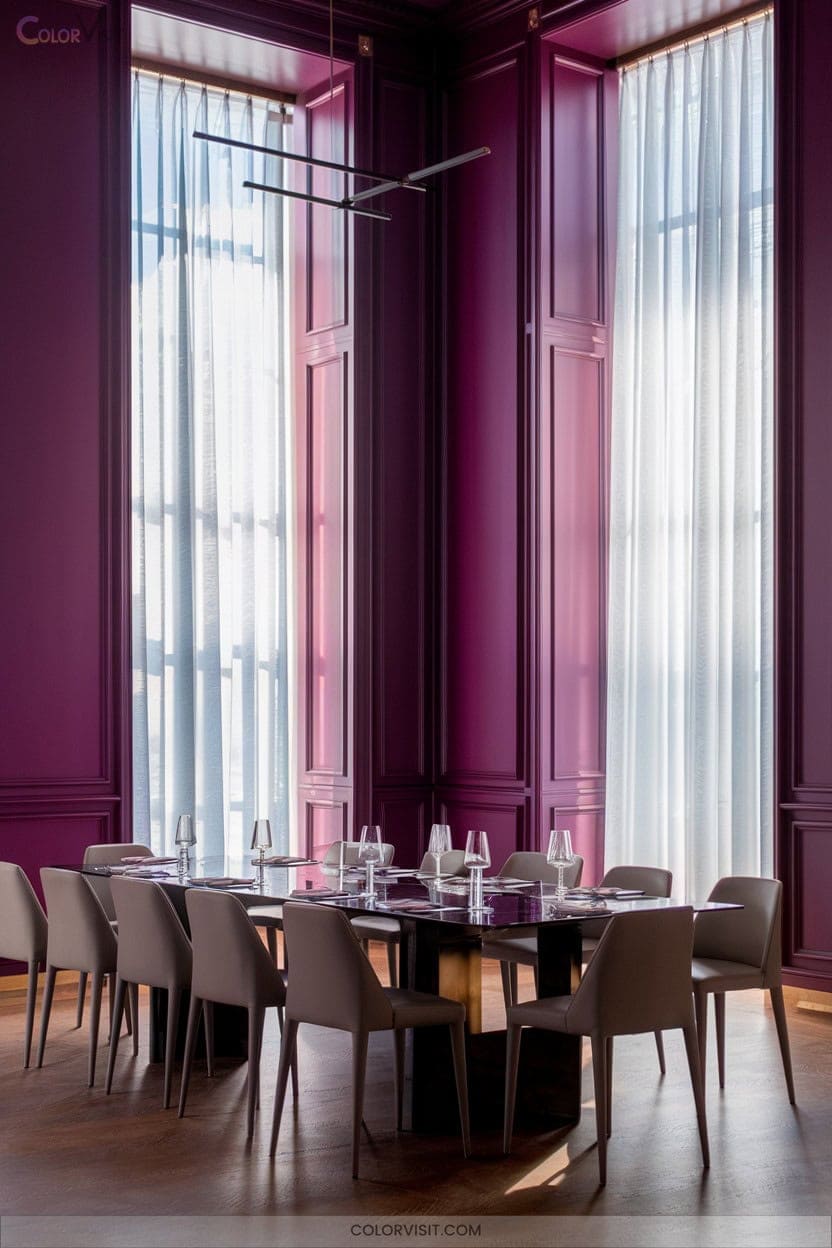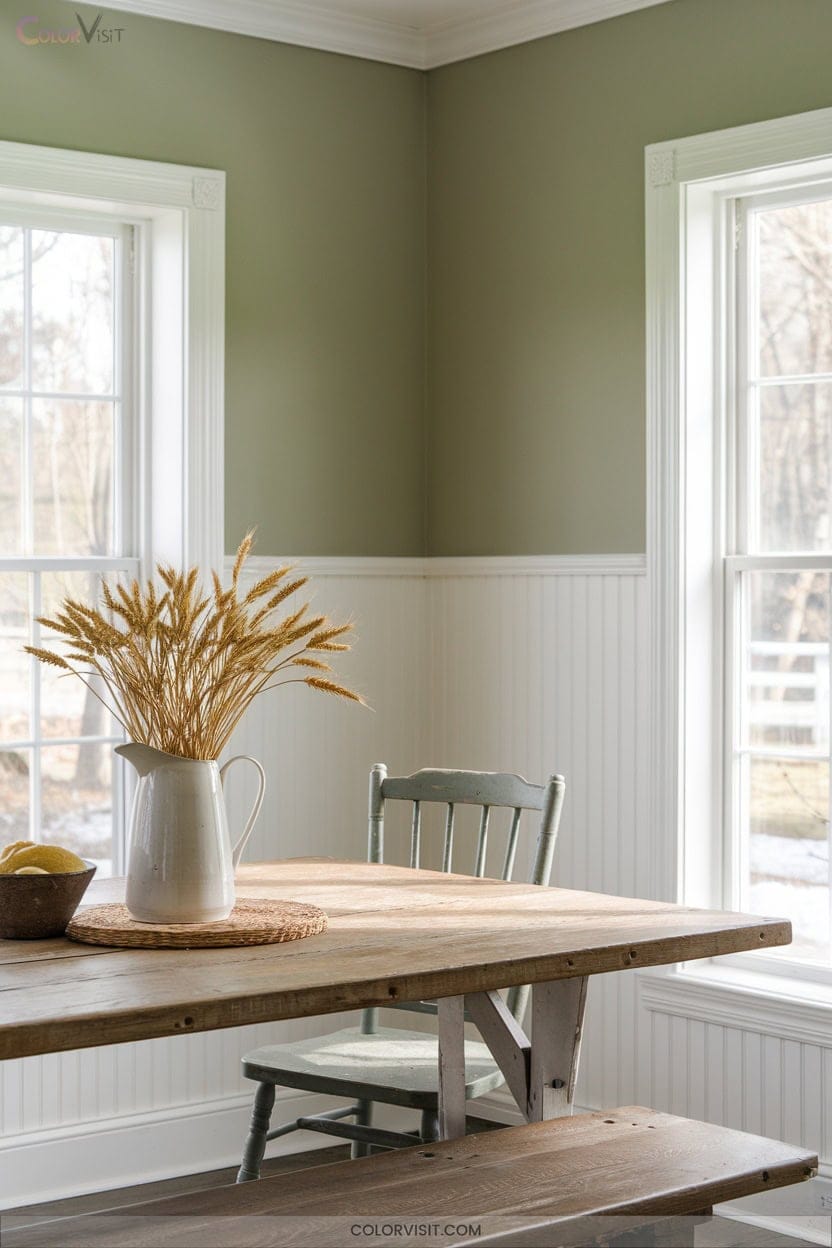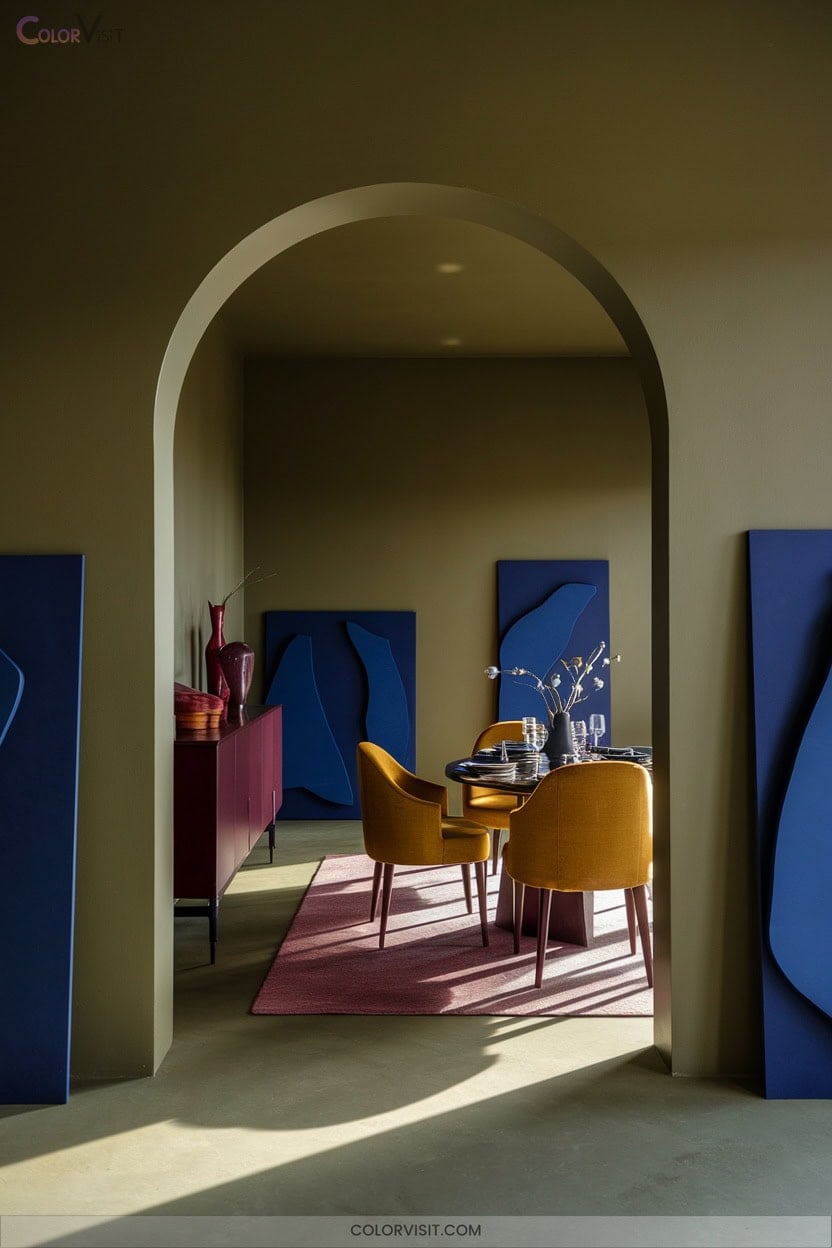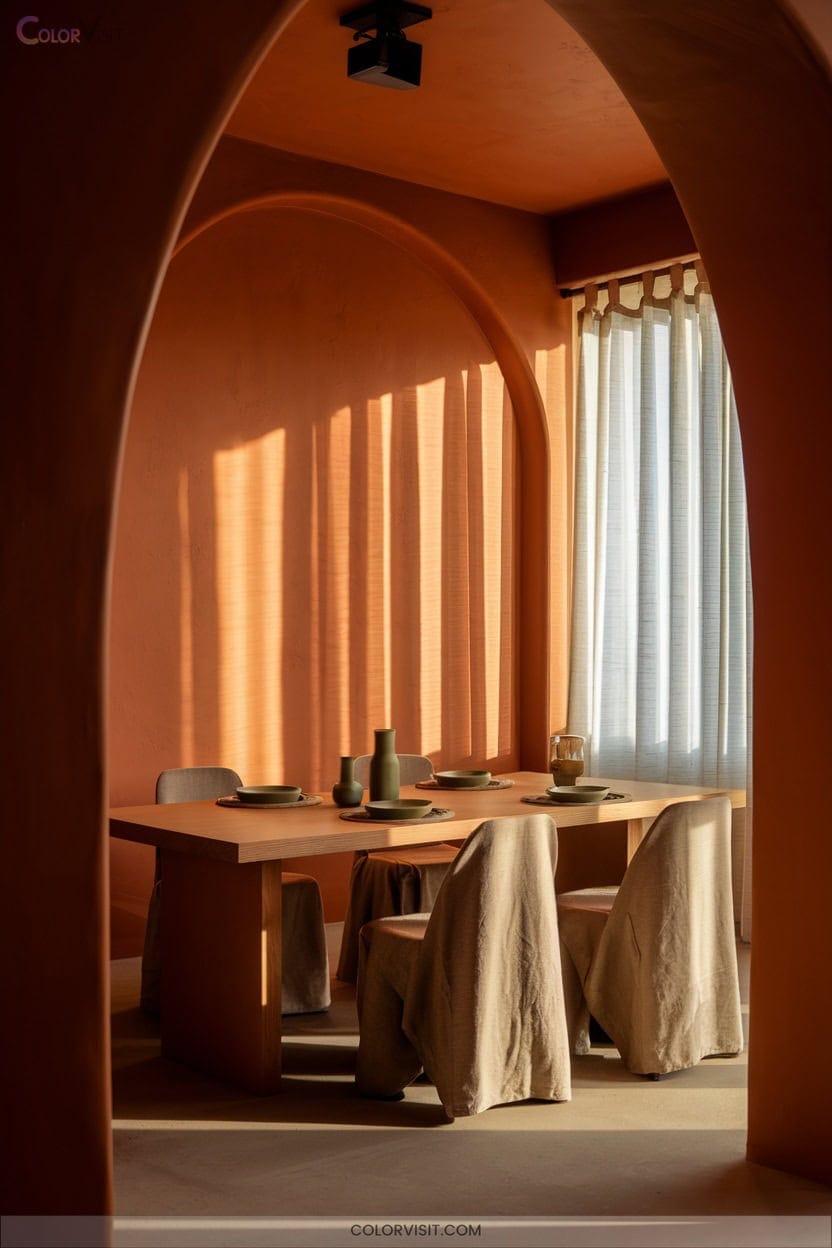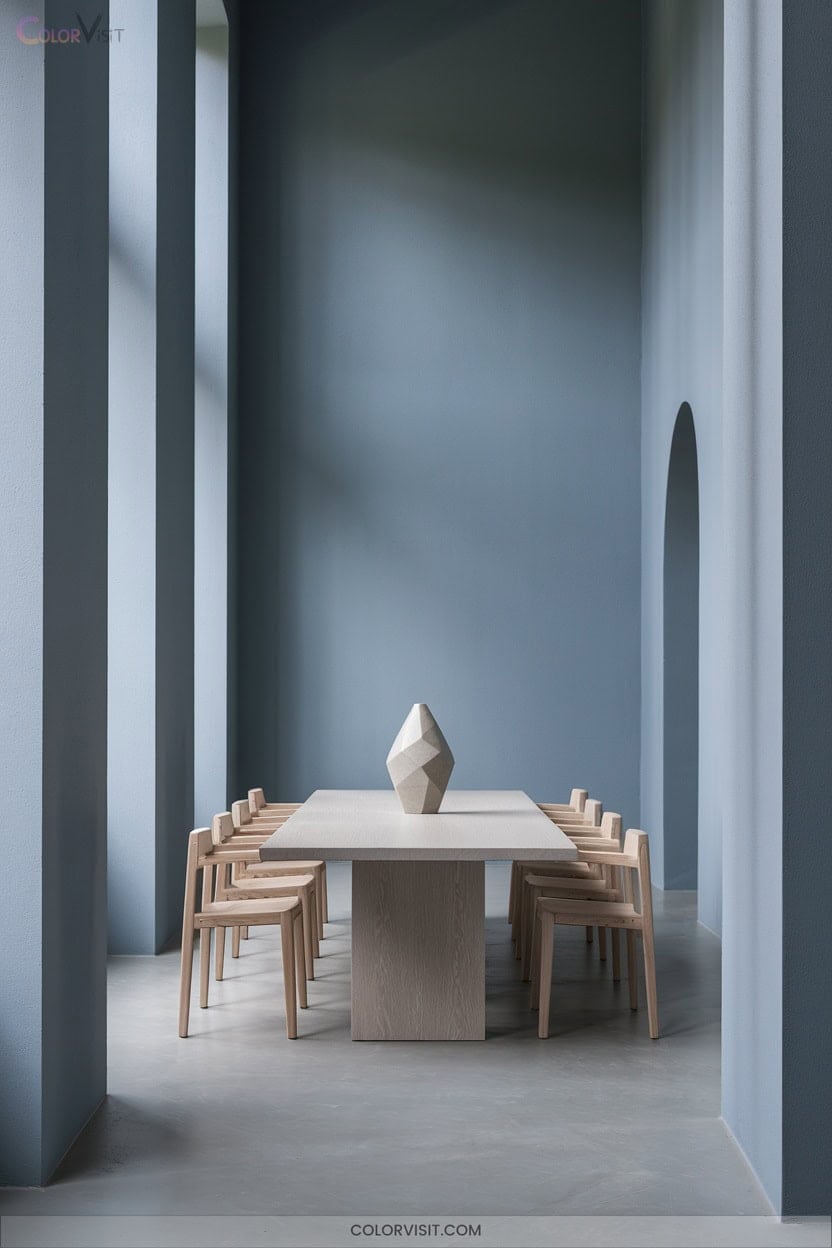16 Elegant Dining Room Color Scheme Ideas for Entertaining Spaces
Elevate your dining room with gallery-white walls and curated art, or embrace greige foundations for timeless, layered appeal. Try navy with crisp trim for bold contrast, or go emerald and gold for luxe sophistication. Warm terracotta offers Mediterranean charm, while amethyst purple brings regal drama.
Earthy mid-tones grounded by stone and wood balance modernity and comfort. Illuminate these palettes with metallics, sculptural lighting, and organic textures—discover which combinations create the perfect scene for unforgettable entertaining as you explore further.
1. Classic White Gallery Walls
A classic white gallery wall instantly elevates your dining room, setting a crisp, sophisticated backdrop that’s both timeless and on-trend.
Curate visual intrigue by mixing frame styles—matte white, black, wood, or gold—layering in mirrors to amplify light and depth.
Arrange artwork in varied sizes for dynamic hierarchy; anchor compositions above a console for a deliberate focal point.
Blend modern abstractions with classical engravings, balancing innovation with tradition.
Precision matters: maintain 2–3 inches between frames, align with molding, and pre-map layouts for seamless flow.
Integrate statement chandeliers, layered lighting, and subtle metallics to accentuate your curated, luminous space.
2. Greige Foundations for Timeless Style
Greige delivers a sophisticated, on-trend neutral foundation that effortlessly bridges modern and traditional dining room aesthetics.
By merging the warmth of beige with the cool restraint of gray, greige sets a calm, versatile backdrop primed for innovative design.
Greige blends beige’s warmth and gray’s coolness, creating a serene, flexible backdrop ready for inspired, contemporary design.
Its chameleon quality lets you layer in tactile elements—think organic wood, woven textures, and eclectic Moroccan rugs—for visual dynamism.
Pair greige walls with metallic accents or pastel accessories to amplify both serenity and style.
Integrate richly colored rugs or ochre tones for depth, while natural textiles provide tactile harmony.
With greige, you create a timeless canvas that embraces evolving trends and personal expression.
3. Warm Taupe for Sophisticated Comfort
Taupe radiates understated elegance, enveloping your dining room in sophisticated comfort that feels both modern and enduring.
The nuanced blend of brown and gray creates a dynamic backdrop, exuding warmth while maintaining a refined, versatile aesthetic.
Embrace taupe’s ability to adapt across styles—whether you favor minimalist, contemporary, or rustic-chic atmospheres.
The latest design trends elevate taupe with bold color pairings, dramatic lighting, and curated decor for a truly inviting space.
- Pair taupe walls with deep burgundy or aubergine accents for visual depth.
- Incorporate layered, warm lighting for a luxe ambiance.
- Choose natural wood furnishings to amplify warmth.
- Display modern art for elevated intrigue.
4. Pale Ivory and Dark Wood Pairings
Contrast defines luxury when you pair pale ivory walls with the rich tones of dark wood in your dining room.
This high-impact combination anchors the space with visual gravitas while maintaining luminosity.
Incorporate walnut or espresso dining tables and chairs to create depth, then introduce light flooring for harmonious balance.
Cream trim and neutral accessories keep the palette cohesive, while metallic highlights—think brushed gold or silver—inject a modern edge.
For trend-forward appeal, layer navy blue accents and sculptural greenery.
Opt for soft, dimmable lighting to enhance ambiance, allowing every dinner party to showcase both innovation and timeless sophistication.
5. Soft Linen for Understated Elegance
After exploring the dramatic allure of pale ivory and dark wood, consider the quiet sophistication that Soft Linen brings to a dining space.
This oatmeal white, with warm peach undertones, sets a refined, inviting foundation ideal for innovative entertaining.
Its versatility anchors both modern and classic aesthetics while maximizing light and spatial perception.
Use Soft Linen as your canvas for tactile layering and dynamic accent colors—think muted oranges or soft blues.
Achieve understated elegance by integrating:
- Matte or eggshell paint finishes for subtle depth
- Natural linen textiles on chairs and tables
- Brushed metallic accents for modern flair
- Woven baskets and organic decor for texture
6. Navy Blue and White Trim Harmony
A timeless choice for sophisticated dining spaces, navy blue walls paired with crisp white trim deliver instant visual drama and balance.
Embrace this high-contrast palette by selecting Sherwin Williams Naval Blue or Benjamin Moore Slate Blue for depth, then accentuate architectural moldings with snowy or cream whites.
Integrate gold-finish pendant lighting and mirrors with white frames to amplify both light and luxury.
Opt for neutral or white furniture, layered with navy and white-patterned textiles for cohesion.
Light-colored rugs and dimmable, warm LED lighting further enhance ambiance.
This harmonious scheme epitomizes contemporary elegance, offering a refined backdrop for dynamic entertaining experiences.
7. Emerald Green Statement Spaces
Move beyond classic blue-and-white refinement by introducing the rich vibrancy of emerald green to your dining room.
This jewel tone instantly elevates the space, giving it an avant-garde, luxurious edge.
Emerald green walls create a dramatic backdrop, while gold accents and metallic lighting amplify the look’s sophistication.
Emerald green walls set a dramatic stage as gold accents and metallic lighting elevate the room’s sophistication.
Balance is key—pairing green with crisp white trim or light flooring maintains a fresh, contemporary vibe.
Don’t overlook statement surfaces like emerald marble tables or lush rugs for extra depth.
- Paint a statement wall in emerald green for dramatic impact
- Incorporate emerald chairs or accent pieces
- Layer gold metallics for luxe contrast
- Use light flooring and white trim to balance intensity
8. Deep Claret Red and Olive Accents
Rich and nuanced, deep claret red paired with olive accents channels the timeless drama of historic estates while offering a distinctly modern allure.
This sophisticated palette leverages the muted warmth of claret red—evocative of aged wine—to establish a sumptuous, conversation-worthy backdrop for entertaining.
Olive green delivers a striking counterpoint, infusing natural balance and visual intrigue.
Integrate these hues through curated upholstery, accent walls, or artful accessories for cohesive impact.
To optimize ambiance, layer neutral textiles and employ dim, warm lighting for intimacy.
The result is a dining space that’s both inviting and bold—ideal for the innovation-driven entertainer.
9. Sapphire Blue Ceilings for Intimacy
While deep claret red and olive accents evoke grounded warmth, sapphire blue ceilings elevate your dining room with a sense of intimacy and opulence.
This bold hue establishes a dramatic visual hierarchy, seamlessly distinguishing your dining zone in open-plan layouts.
Pair it with lighter walls and matte finishes for contemporary contrast, and leverage dimmer-controlled lighting to amplify its depth.
Sapphire blue’s psychological effect—calm luxury—makes it a sophisticated choice for formal entertaining.
Integrate tactile elements like velvet textiles and polished hardwood to harmonize style and comfort.
- Balance with soft ambient or recessed lighting
- Use fade-resistant, matte paint finishes
- Pair with metallic or wooden furniture
- Complement with light-toned wall treatments
10. Amethyst Purple for Regal Flair
A statement-making choice, amethyst purple infuses your dining room with regal flair and timeless sophistication.
Amethyst purple brings regal flair and timeless sophistication to your dining room, creating an unforgettable, statement-making atmosphere.
This deep violet pigment, rich in historical significance, instantly elevates entertaining spaces.
Embrace its versatility—layer pale tones like Orchid Mist for subtle elegance, or opt for saturated hues for maximum impact in expansive rooms.
Pair amethyst with cool greys or crisp whites for modern contrast, or intensify with mauve and violet for a sumptuous palette.
Dark wood furnishings and metallic gold or silver accents magnify the luxury factor.
For tactile depth, integrate velvet or silk textiles and let strategic lighting highlight the color’s rich undertones.
11. Sage Green With Farmhouse Charm
After exploring the bold sophistication of amethyst purple, consider the serene appeal of sage green for a dining room that channels farmhouse charm.
Sage green’s muted undertone sets an innovative, calming backdrop, letting organic textures and rustic elements command visual interest.
Pair this hue with reclaimed wood, linen textiles, and wrought iron for a tactile, layered ambiance that feels both curated and inviting.
Harness natural light to amplify the airy, contemporary farmhouse mood.
- Mix oak or pine tables with bench seating for practical elegance
- Choose open shelving with curated farmhouse dishware
- Add woven baskets or vintage pottery for tactile depth
- Layer warm lighting with industrial farmhouse fixtures
12. Olive Walls and Vibrant Contrasts
Olive walls infuse your dining room with grounded sophistication, effortlessly bridging timeless elegance and modern edge.
Olive walls bring grounded sophistication to your dining room, blending classic charm with a sleek, modern sensibility.
Amplify this refined palette with vibrant contrasts—think bold artwork that pops against the muted green, or geometric rugs that introduce kinetic energy.
Metallic pendant lighting and gold accents elevate the ambiance, while contemporary furniture offsets olive’s vintage undertones with sleek profiles.
Integrate wooden tables for organic warmth, and layer in patterned textiles to spark visual intrigue.
13. Earthy Mid-Tones With Taiga
Why settle for predictable when you can envelop your dining space in the grounded serenity of earthy mid-tones like Sherwin-Williams Taiga?
This sophisticated green, inspired by untamed forests, creates a calming backdrop that’s anything but ordinary.
Integrate wooden furniture and natural textiles to amplify the organic aesthetic, while strategic lighting—think woven rattan or layered fixtures—deepens the ambiance.
Balance Taiga’s richness with cooler accents and tactile materials for a multi-dimensional, trend-forward look.
Achieve a harmonious, innovative dining environment with these expert moves:
- Pair Taiga with forest green accent walls for visual depth
- Incorporate stone or brick for textural intrigue
- Use natural fiber rugs for warmth
- Layer slate gray or navy blue accents for balance
14. Warm Terracotta Mediterranean Vibes
How do you instantly channel the warmth and elegance of the Mediterranean into your dining room?
Start with terracotta—this sun-baked hue creates an inviting, on-trend foundation reminiscent of rustic tiles and earthenware.
Terracotta sets a welcoming, sun-drenched stage, echoing the warmth of Mediterranean tiles and timeless earthenware.
Pair vibrant peachy terracotta or Tuscan reds with crisp whites, golden yellows, and olive green accents for visual balance and regional authenticity.
Integrate solid wood tables, woven textiles, and vintage Mediterranean décor to elevate the ambiance.
Burnt oranges, faded terracotta, and subtle coral undertones add depth and energy.
Finish with soft, warm lighting and bold floral arrangements for a dynamic, innovative space perfect for inspired entertaining.
15. Aleutian Blue-Gray for Contemporary Minimalism
A refined approach to contemporary minimalism, Aleutian Blue-Gray (SW 6241) infuses your dining room with a serene, denim-inspired sophistication that’s both cool and inviting.
This versatile hue adapts fluidly to shifting daylight, shifting from airy to atmospheric with ease.
Pair it with streamlined furniture and subtle metallics for a curated, gallery-like ambiance.
The psychological calm of Aleutian fosters relaxed, conversation-driven gatherings and makes your entertaining space feel effortlessly current.
- Layer with crisp whites and organic wood for visual balance.
- Integrate brass or chrome accents for modern contrast.
- Opt for matte finishes to amplify tranquility.
- Use layered lighting for dimensional depth.
16. High-Contrast Blackened Navy and White
Statement-making contrast defines the allure of a blackened navy and white dining room, where deep indigo undertones meet crisp, luminous surfaces.
Opt for two-tone walls with navy and white to create a compelling backdrop, ideal for highlighting curated artwork or metallic wall sculptures.
Anchor the space with a white marble table and navy-upholstered or black leather chairs.
Integrate geometric black-and-white textiles—think rugs or drapery—for visual rhythm.
Layer in gold or chrome accents through lighting and décor for heightened sophistication.
Complete your innovative statement with ambient lighting, navy glass sconces, and white florals for a bold, contemporary, and elegant entertaining zone.
Frequently Asked Questions
How Do Lighting Conditions Affect Dining Room Paint Color Appearance?
You’ll notice lighting dramatically transforms paint color perception. Warm lighting amplifies richness in hues, while cool lighting sharpens cool tones. Test swatches under varied lighting to guarantee your chosen palette maintains its intended sophistication, vibrancy, and contemporary appeal.
What Wall Colors Help Make a Small Dining Room Feel Larger?
You might worry pale colors seem bland, but when you use high-gloss finishes, soft monochromatic palettes, and metallic accents, you’ll amplify light, craft seamless flow, and stay on-trend—instantly transforming compact dining zones into visually expansive, innovative spaces.
Are Certain Dining Room Colors Better for Increasing Appetite?
Yes, you’ll boost appetite by embracing warm hues—think terracotta, saffron, or muted coral. These tones stimulate visual appetite cues and align with biophilic trends, so your dining space feels both on-trend and sensorially inviting.
Can Bold Color Schemes Work With Open-Concept Dining Areas?
Absolutely, you can leverage bold color schemes in open-concept dining areas to define zones and create visual drama. Use saturated hues strategically—think accent walls, statement chairs, or jewel-toned accessories—to maintain flow while showcasing cutting-edge design sensibility.
How Do You Transition Dining Room Colors to Adjoining Spaces?
You transform dining room colors by leveraging analogous or monochromatic palettes, coordinating trim, and incorporating tonal gradation. Integrate trending elements—like statement rugs and consistent lighting—to achieve visual connectivity and seamless flow between innovative, adjoining spaces.
Conclusion
As you curate your dining room’s palette, remember that even the most restrained hues can quietly orchestrate a sense of refinement. Embrace muted sophistication—whether it’s the hush of linen or the subtle drama of blackened navy—for a space that gently encourages conviviality.
With these trend-forward, nuanced color schemes, you create more than just a room; you’re subtly setting the stage for gatherings where conversation lingers and memories are made, all under the gentle hand of considered design. By incorporating welcoming hall room color ideas, you can further enhance the atmosphere, inviting guests to feel at ease from the moment they enter. These shades not only complement your chosen decor but also create a harmonious flow throughout your space. Ultimately, a thoughtfully curated color palette can transform your home into a sanctuary where both relaxation and connection thrive. These inviting palettes invite warmth and intimacy, encouraging friends and family to bask in each other’s company. Explore cozy sitting room color ideas that blend rich earth tones with soft pastels, creating a harmonious balance that suits various moods. Ultimately, every choice adds a layer to the ambiance, nurturing a space where stories unfold and cherished moments are celebrated.


